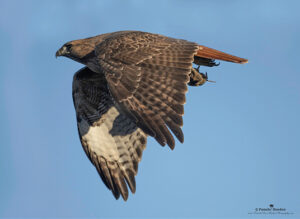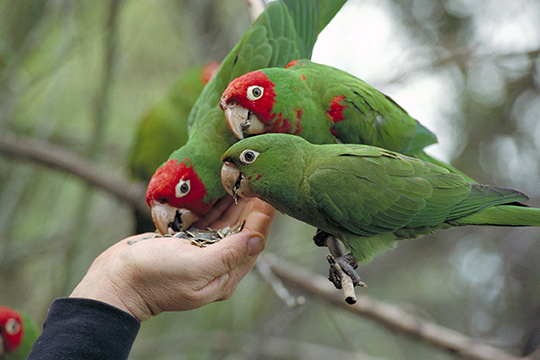by Joe Eaton

(Full article from RATS Tales July 2023)
The neurotoxin bromethalin, introduced in 1985 as a response to increasing rodent resistance to first-generation anticoagulant rodenticides (FGARs), has been touted as a safer alternative to anticoagulants. Recent studies, though, suggest that it may be a significant threat to non-target wildlife like raptors and mammalian carnivores. In a recent publication the journal Environmental Pollution, Maureen Murray of Tufts University and her co-authors report the presence of desmethlybromethalin (DMB), an even more toxic metabolic product of bromethalin, in the adipose (fat) tissues of 29 percent of 44 Massachusetts raptors that were admitted to the university’s Wildlife Clinic in 2021 and 2022. This included 9 red-tailed hawks, 2 barred owls, and 2 eastern screech-owls; the single great horned owl in the sample tested negative. The authors also note the detection of DMB in a bald eagle with neurologic signs similar to those that indicate bromethalin poisoning in mammals.
Bromethalin attacks the mitochondria of nerve cells, causing paralysis, convulsions, and death. There is no known antidote. Toxicity data is patchy: domestic cats are extremely sensitive to bromethalin, dogs less so; guinea pigs appear resistant. Lethal dose information has been established for quail in laboratory studies, but not for hawks or owls. Postmortem diagnosis of bromethalin poisoning is fiendishly difficult, and only a handful of labs—including the California Animal Health and Food Safety Laboratory (CAHFS) at UC Davis where the Massachusetts samples were analyzed—are equipped to test for it. Murray and her co-authors point out that necropsies don’t always detect physical abnormalities, and false positives are possible.
Bromethalin has been detected in wild mammals in California since at least 2013. A CAHFS conference presentation tallied 55 cases of exposure from that year through 2016, predominantly in raccoons and striped skunks. Since then, additional mammal species have tested positive for bromethalin. The California Department of Fish and Wildlife (CDFW), in its annual reports of pesticide exposures and mortalities for 2021 and 2022, reported detections in black bears, long-tailed weasels, coyotes, gray foxes, mountain lions, and bobcats, in addition to skunks and raccoons. Bobcats had 11 exposures in 2021; mountain lions had 4. Toxicosis was confirmed for 5 raccoons, 3 skunks, and one fox. The reports didn’t mention DMB.
One of the CDFW reports noted that a mountain lion and bobcat that tested positive for bromethalin had “pathological findings suggestive of vehicular trauma,” which suggests that sublethal effects of bromethalin poisoning might have made the cats more vulnerable to motor vehicle strikes. The deaths directly caused by bromethalin would have been agonizing. A CAHFS newsletter described 2 juvenile raccoons that suffered “ascending progressive paralysis from the hind legs to the throat and mouth” before they were euthanized. A black bear experienced loss of muscle control and a fatal reduction in the number of red and white blood cells and platelets.
Omnivorous raccoons, skunks, and bears might have eaten bromethalin bait. Bromethalin bait residue was actually found in the digestive tract of one California raccoon. But the coyotes and foxes most likely and the bobcats and weasels almost certainly would have been exposed by consuming a poisoned rodent. The mountain lions could have eaten coyotes or bobcats that had eaten rodents—a case of tertiary exposure.
In California, unlike Massachusetts, bromethalin has not surfaced as an issue for raptors or other wild birds. CAHFS veterinarian Chelsea Syskes said in email that the lab had “only rarely analyzed samples from wild birds in California or elsewhere.” Sykes checked the lab’s archives from 2010 on and found no positive detections of bromethalin in a wild bird in California. “We may test birds for bromethalin if indicated in the bird’s history (e.g., clinical signs, species) and/or findings during the postmortem exam.,” said Krysta Rogers, CDFW’s lead on avian investigations “At this time, I’m not aware of any confirmed detections in wild birds in California, although relatively few birds have been tested.” The exception: San Francisco’s population of feral parrots, known as red-masked parakeets to ornithologists and cherry-headed conures in the cage bird trade. In 2018, analysis at the University of Georgia’s Infectious Disease Laboratory found bromethalin in fecal samples and brain and liver tissue from several parakeets that presented neurologic signs characteristic of bromethalin poisoning.

Given the multiple detections of bromethalin in carnivorous and omnivorous mammals in California, it’s hard to believe that raptors and other birds—including ravens, which have been known to eat AR bait—aren’t also being affected. More testing may substantiate that. Other unknowns include the possibility of interactions or additive effects between bromethalin and ARs. In the Massachusetts study, almost all of the hawks and owls had at least trace amounts of ARs in their livers, predominantly the second-generation AR (SGAR) brodifacoum, but also the FGARs chlorophacinone and diphacinone and the SGARs bromadiolone, difethialone, and difenacoum. AR poisoning was identified as the cause of death for all 9 red-tailed hawks and one barred owl. Did exposure to bromethalin make the birds more susceptible to the ARs?
“There is minimal experimental evidence for or against the ability of bromethalin or DMB to bioaccumulate in predatory species and cause toxicosis via secondary ingestion,” Murray and her co-authors caution. But their study clearly demonstrates that bioaccumulation and secondary poisoning are happening in the wild, and the CDFW data strongly suggests that’s the case for nontarget mammals as well as birds. This counters the notion of bromethalin as a lesser evil. With trapping, exclusion and other preventive measures, and encouraging the presence of rodent-eating raptors, rodent control without collateral damage to nontarget wildlife is possible. Swapping one poison for another is not the answer.
